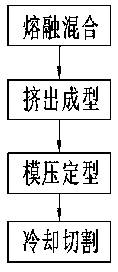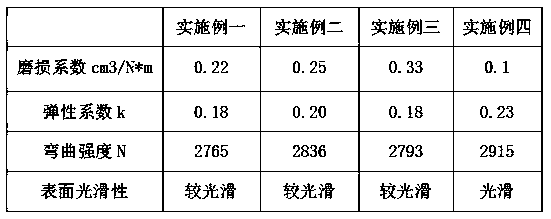Wear-resistant wood-plastic floor and manufacturing method
A technology of wood-plastic floor and manufacturing method, which is applied in the field of wood-plastic floor, can solve problems such as high cost, difficult preparation, and complicated production process, and achieve the effects of low cost, reduced oxidation rate, and improved service life
- Summary
- Abstract
- Description
- Claims
- Application Information
AI Technical Summary
Problems solved by technology
Method used
Image
Examples
Embodiment 1
[0055] A wear-resistant wood-plastic floor is made of the following raw materials in parts by weight:
[0056] 35-38 copies of PET;
[0057] 30-35 parts of plant fiber;
[0058] 8-9 parts of aluminum oxide;
[0059] 2 to 5 parts of coloring agent;
[0060] 2 to 3 parts of plasticizer;
[0061] 4-7 parts of stabilizer;
[0062] 3 to 4 parts of lubricant.
[0063] Further, the PET materials are recycled mineral water bottles and carbonated beverage bottles; the plant fibers are made of rice husks, rice straw, wheat straw, corn straw, cotton stalks, wood chips, bamboo chips and other crop straws or stems of other plants. 10-200 mesh plant fiber powder, and then use special technology to make mixed raw materials; plasticizers are phthalates, terephthalates, benzoates, benzoates, polyol esters One of them, epoxies, citric acid esters and polyesters, preferably polyol lipids; the coloring agent is one of organic dyes and inorganic pigments, preferably organic dyes.
[0064] A...
Embodiment 2
[0071] A wear-resistant wood-plastic floor is made of the following raw materials in parts by weight:
[0072] 38-41 copies of PET;
[0073] 35-38 parts of plant fiber;
[0074] 9-10 parts of aluminum oxide;
[0075] 2 to 5 parts of coloring agent;
[0076] 2 to 3 parts of plasticizer;
[0077] 4-7 parts of stabilizer;
[0078] 3 to 4 parts of lubricant.
[0079] Further, the PET materials are recycled mineral water bottles and carbonated beverage bottles; the plant fibers are made of rice husks, rice straw, wheat straw, corn straw, cotton stalks, wood chips, bamboo chips and other crop straws or stems of other plants. 10-200 mesh plant fiber powder, and then use special technology to make mixed raw materials; plasticizers are phthalates, terephthalates, benzoates, benzoates, polyol esters One of them, epoxies, citric acid esters and polyesters, preferably polyol lipids; the coloring agent is one of organic dyes and inorganic pigments, preferably organic dyes.
[0080] ...
Embodiment 3
[0087] A wear-resistant wood-plastic floor is made of the following raw materials in parts by weight:
[0088] 38-41 copies of PET;
[0089] 30-35 parts of plant fiber;
[0090] 9-10 parts of aluminum oxide;
[0091] 2 to 5 parts of coloring agent;
[0092] 2 to 3 parts of plasticizer;
[0093] 4-7 parts of stabilizer;
[0094] 3 to 4 parts of lubricant.
[0095] Further, the PET materials are recycled mineral water bottles and carbonated beverage bottles; the plant fibers are made of rice husks, rice straw, wheat straw, corn straw, cotton stalks, wood chips, bamboo chips and other crop straws or stems of other plants. 10-200 mesh plant fiber powder, and then use special technology to make mixed raw materials; plasticizers are phthalates, terephthalates, benzoates, benzoates, polyol esters One of them, epoxies, citric acid esters and polyesters, preferably polyol lipids; the coloring agent is one of organic dyes and inorganic pigments, preferably organic dyes.
[0096] ...
PUM
 Login to View More
Login to View More Abstract
Description
Claims
Application Information
 Login to View More
Login to View More - R&D
- Intellectual Property
- Life Sciences
- Materials
- Tech Scout
- Unparalleled Data Quality
- Higher Quality Content
- 60% Fewer Hallucinations
Browse by: Latest US Patents, China's latest patents, Technical Efficacy Thesaurus, Application Domain, Technology Topic, Popular Technical Reports.
© 2025 PatSnap. All rights reserved.Legal|Privacy policy|Modern Slavery Act Transparency Statement|Sitemap|About US| Contact US: help@patsnap.com



